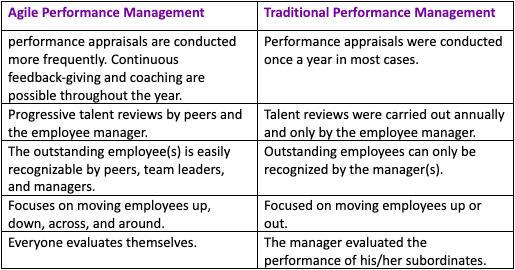A shift to remote work means that your teams won’t have face-to-face interactions. As challenging as it may sound, implementing the agile methodology can help your remote teams overcome the main challenges and even thrive. Despite this realization, most HR leaders are still using traditional practices to manage remote teams.
At NoHQ—one of the best resources for veteran remote workers, we believe that this should not be the case in your organization. With this right technology in place, adopting agile HR can help your talented remote team deliver just as much value as a co-located team.
To achieve this, you first need to understand agility principles and then apply them to facilitate organizational transformation. Throughout this guide, you will learn:
- What agile means in HR
- The difference between traditional and agile HR management
- The importance of Agile HR for remote teams
- How HR can apply agile practices in managing remote teams
What is Agile HR?
Agility refers to the ability of an organization to create competitive solutions, increase speed to market, and meet emerging customer needs. With its origins in the Agile Manifesto, the agile methodology was initially used in the software development and project management industries.
It has since been adopted by other industries and departments to improve product speed-to-market, team collaboration, efficiency, and customer satisfaction. From a business perspective, agile refers to workforce agility, which entails matching your workforce fluctuations to the prevailing demand.
What Does Being Agile Mean in HR Management for Remote Teams?
Traditionally, agile teams thrive when the members are co-located. So, how can you ensure that they remain effective now that they are working remotely? Some of the fundamental aspects of agility include face-to-face communication and daily collaboration.
The main objective for agile HR in your team should be to add value, quality, predictability, and be able to respond to change.
Your agile remote team can take advantage of online tools for collaboration, and self-organize while maintaining a strong team culture. In particular, you can take advantage of both synchronous and asynchronous tools for communication for effective collaboration. Here are some tools that you can use:
Synchronous:
- Call: Slack, Google Meets, Zoom
- Chat: Microsoft Teams, Slack
Asynchronous:
- Documentation: Notion
- Email: Gmail
- Video recording: Loom
If applied properly, the agile approach can help your team have shorter work cycles as well as improve collaboration and group contribution.
Rather than having each employee working independently, agile HR requires your teams to collaborate throughout the design, development, and delivery of HR initiatives.
Agile HR vs. Traditional HR Practices
Traditional human resource management focuses on a strict set of rules and standards that are often implemented in a strict hierarchical structure. On the contrary, Agile HR management shifts the focus to a faster and simpler approach that prioritizes feedback, collaboration, and innovation.
While managing your teams, you need to move away from the conventional rules- and planning-based approach. Instead, you must develop initiatives and programs that empower as well as engage your remote workers
As you enter the agile age, your HR management should focus on such things as:
- Working in small teams, of 7 to 10 employees, and in short cycles
- Delivering improved customer satisfaction and engagement
- Reducing networked organizational arrangements and micromanagement
Why is Agile Important in HR?
The human resources department in your organization cuts across several other departments. As such, the ability of HR to influence the assimilation of a transformation in your organization is significant. An agile workforce helps your organization grow successfully.
A more agile approach to human resources management can benefit your remote teams in many ways, including:
Continuous Feedback
Proper implementation of Agile in HR makes it possible for you to receive regular feedback consistently. As an HR leader, this equips you with the information you need to develop relevant and effective solutions.
Seamless Team Collaboration
Agile HR allows for improved communication. This, in turn, makes it easy for employees in different departments to work as a team. Agile also encourages transparency, which elevates trust across the team.
Better Output Assessment
Agile in HR emphasizes results as well. This is often displayed using visualizations on the relevant dashboards. As a result, your human resources department can accurately predict results in relation to time, performance, and cost for any given initiative.
Improved Adaptability
Some of the key objectives of the agile methodology are to test, learn, and optimize. These will come in handy whenever you need a rapid response to changing conditions.
Tips on How to Apply Agile to HR to Help Your Remote Teams Thrive
Adopting Agile HR was one of the topics featured at the 2019 SHRM conference in Las Vegas. This shows how important the agile approach is when it comes to the formulation of organizational strategies. Agile in HR can reinvent and modernize the operational model in your organization.
Adopting Agile HR was one of the topics featured at the 2019 SHRM conference in Las Vegas. This shows how important the agile approach is when it comes to the formulation of organizational strategies. Agile in HR can reinvent and modernize the operational model in your organization.
There are different agile HR solutions and techniques that you can apply to your HR. Discussed below are some of the ways you can adopt the agile methodology in your remote teams:
a. Set Clear Milestones
In most cases, remote HR leaders do not set clear Milestones for their team members. They simply assign tasks to remote team members directly and expect the employees to manage all the deliverables on their own. Agile HR requires team leaders to come up with details regarding the final deliverable.
You need to plan and set clear Milestones for each sprint, regardless of whether the task is simple or complex. This way, your remote workers get to know the expectations, goals, and timelines for each project beforehand.
Again, planning the Milestones before starting can also ensure that you get all the details right for the successful completion of the project. This ensures that you do not experience any bottlenecks that come with incomplete information.
b. Build Rapport and Team Spirit
To build solid rapport across your remote team, split your projects into short sprints and have regular check-ins with the remote team members. Emphasize building personal connections with your remote workers, even if it is through quick, daily meetings.
This prevents confusion and helps boost team morale while keeping the team self-organized. Such agile HR efforts can help your remote team improve rapport, team camaraderie, collaboration as well as overall team efficiency.
c. Frontline Decision-Making Rights
The Implementation of agile HR practices often has to do with facilitation and engagement. In this regard, you should empower frontline people in your remote teams to make decisions, be accountable, and learn from their mistakes. For example, you can initiate an agile team culture by implementing such processes as retrospectives—team meetings often held after an iteration or project completion.
Through retrospectives, team members can discuss how a project went, assess their work, and make relevant improvements. Retrospectives will also come in handy when you need to identify opportunities for improvement or evaluate the decision-making process in your organization.
d. Hold Regular Stand-Ups to Connect With Your Remote Teams
Stand-Ups are quick, meetings that are held bet remote teams daily. You can use these to stay connected with your team members and keep them updated. The agile and short nature of these meetings makes them an easy meeting structure for remote teams to implement.
Set aside 10 to 15 minutes every day to hold a stand-up meeting with your team members. During the meeting, every member should take a turn to share progress updates on the task they have been working on. Every member should also express any difficulties they may have faced while working on their current assignment.
These meetings are also a great way for remote teams to foster a sense of camaraderie and uplift the team spirit. This stand-up meetings essential for remote workers who don’t get to have regular face-to-face interactions with other team members.
e. Incorporate Agile Performance Management Practices
Traditional HR management in many organizations includes annual performance reviews. However, performance feedback on these would often come once a year from the HR leaders. To make this practice more effective, you should find more effective ways to evaluate employee performance.
Agile performance management encourages frequent reviews. This way, teams can get immediate feedback more frequently. As such, they are in a better position to correct mistakes, and better their performance. For instance, you could use role-based performance scales to examine your employees’ contributions outside their job roles.
Using the scale, you can easily determine how different employees have helped each other or have contributed to the overall development of your organization.

Table 1: Traditional Performance Management vs. Agile Performance Management
f. Enhance Your Managers’ Coaching Skills
With traditional HR management, much of the focus is on individuals, their performance, goals, and needs. If you are still using such an approach, you need to focus on teams and groups for enhanced agility. You should particularly pay attention to coaching skills among your HR leaders.
Rather than controlling your projects and teams using strict structures and standards, empower your teams to deliver their best. Well, this is only possible with skilled coaches to guide the projects. Empower your agile HR teams to collaborate in creating, executing, tracking progress, identifying opportunities for improvement, and assessing leadership.
To achieve this, you could hire on-site professional coaches to help your managers provide better employee feedback. You could also have the professional coaches help in the development of internal training capacities. With better training and teamwork experiences, your managers will eventually become better coaches.
g. Facilitate Agile Rewards and Compensation
Neurological findings show that rewards are more effective at motivating action than punishments. A survey on the same revealed that about 78% of employees are motivated to work harder following a recognition or reward at work.
To keep your employees motivated you may need to adjust compensation for each job from time to time. You could also raise employee salaries when they take on the more challenging projects or just go above. Try to give the outstanding employees in your organization unexpected rewards.
In line with agile HR practices, establish a working environment that encourages peers to recognize their colleagues’ accomplishments. Again, it is advisable to celebrate your employees’ accomplishments publicly. This makes the other employees aware of the behaviors that are rewarded in the organization.
h. Foster Agile Learning and Development
Through learning and development, you can easily instill new Agile HR skills into your workforce. This is why most organizations have online learning modules on their websites. In such a case, employees can visit the modules whenever they need to learn something.
However, agile learning and development require you to employ somewhat different approaches to data analysis. This way, you can easily identify specific jobs, skills, knowledge, or attitudes that require advancement in your organization.
You could then make personalized suggestions to your employees regarding the future jobs and training they need to undertake—based on their interests and experiences. Once you adopt agile HR practices, your employees will have to design their to-do list schedules and education.
Conclusion
Agile business practices have become increasingly important as more HR leaders seek ways they could gain a competitive advantage. The impact of agile in HR is particularly significant in the areas of learning and development, recruitment, engagement, and motivation.
As you can see, implementing agile HR in your remote teams requires a comprehensive approach. It should encompass all your human resources management practices such as recruiting, developing, and retaining employees.
Go agile today for enhanced adaptability, better output assessment, continuous feedback, and seamless team collaboration.
